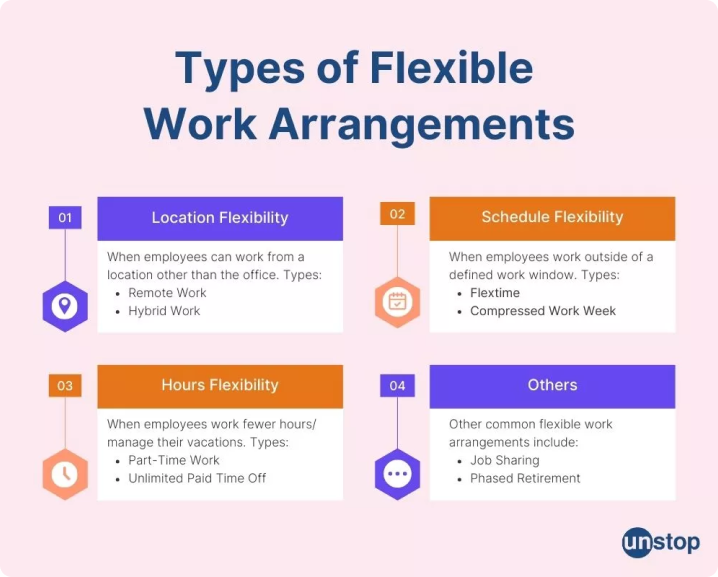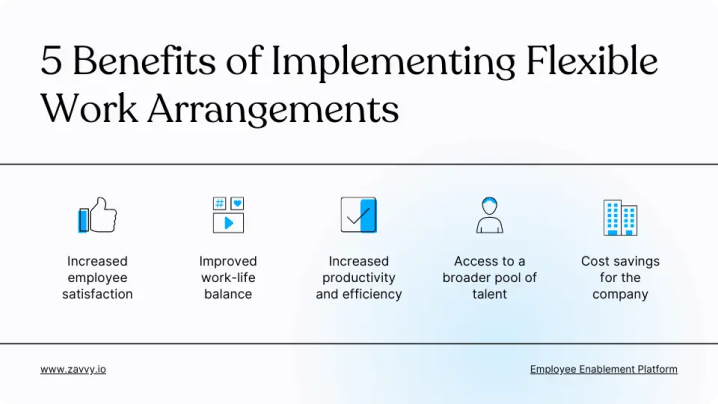The Benefits of Allowing Employees a Flexible Schedule: Work Flexibility at Its Best

Modern workplaces are evolving, and one of the most significant changes in recent years has been the adoption of flexible work arrangements.
Flexibility in scheduling has moved from being a perk to becoming a necessity for many businesses seeking to attract and retain top talent.
But what are the specific advantages of flexible schedules, and how can organizations successfully implement them?
What Are Flexible Work Arrangements?
Flexible work arrangements refer to employment practices that provide employees with the freedom to adjust their work schedules, locations, or both.
Unlike traditional 9-to-5 setups, these arrangements prioritize outcomes over strict adherence to set hours or locations, giving employees greater control over how and when they work.
Flexible work isn’t just about convenience; it represents a shift in workplace culture that recognizes employees’ diverse needs and work styles.
For companies, this adaptability is essential to remain competitive in today’s global, digitally connected economy.
5 Common Types of Flexible Working Arrangements
1. Remote Work
Remote work allows employees to perform their duties from any location outside the office, often from home. It eliminates commutes, supports autonomy, and is enabled by digital tools for communication and collaboration. Remote work has become increasingly popular due to advancements in technology and the global push toward digital transformation.
2. Hybrid Work
Hybrid work combines in-office and remote work, giving employees the choice to split their time between home and the workplace. This arrangement offers the best of both worlds, balancing collaboration and flexibility. Employees gain the freedom of remote work without losing the camaraderie and innovation that often emerge from in-person interactions.

3. The Four-Day Workweek
The four-day workweek condenses full-time hours into four days instead of five. Employees enjoy a longer weekend, while organizations maintain productivity levels by focusing on efficiency. This model is gaining traction worldwide, with studies showing that reduced workweeks often lead to higher productivity and happier employees.
4. Flextime
Flextime allows employees to choose their start and end times within set parameters. For example, an employee might work from 7 a.m. to 3 p.m. instead of the standard 9-to-5 schedule. This option works particularly well for those balancing professional responsibilities with personal or family commitments.
5. Results-Only Work Environment (ROWE)
In a ROWE arrangement, employees are evaluated based on their output rather than hours worked. This model emphasizes trust and responsibility, empowering employees to determine how they achieve their goals. It shifts the focus from micromanagement to empowering autonomy, fostering creativity and innovation.

Maximize productivity of your business
Track employee productivity and simplify work with them
Benefits of Flexible Work Arrangements
Increased Work-Life Balance
Flexible schedules empower employees to manage personal responsibilities, such as childcare or education, without compromising work performance. This balance reduces stress and enhances overall well-being. A strong work-life balance also helps employees avoid burnout, leading to long-term productivity and satisfaction.
Improved Productivity and Creativity
When employees work during their peak productivity hours or in their preferred environments, they often produce higher-quality results and are more innovative in problem-solving. Research consistently shows that employees perform better when they have the flexibility to tailor their schedules to their unique work styles.
Reduced Absenteeism and Presenteeism
Flexibility enables employees to address personal or health issues without taking full days off, decreasing absenteeism. Similarly, they are less likely to be “present” at work but disengaged, boosting overall effectiveness. For employers, this translates to fewer disruptions and more consistent performance.
Successful Recruitment
Organizations offering flexible work options are more attractive to job seekers, especially millennials and Gen Z workers, who prioritize flexibility when choosing employers. Offering flexible schedules demonstrates a commitment to modern workplace values, making companies more competitive in the hiring market.
Better Employee Engagement
Employees who feel trusted and supported are more likely to be engaged in their work. Flexibility fosters this trust, leading to better communication and collaboration among team members. Engaged employees are also more likely to advocate for the company, enhancing its reputation and culture.

Staff Retention
By offering flexibility, companies can retain their top talent, reducing turnover costs and maintaining institutional knowledge. Employees who feel respected and valued are less likely to seek opportunities elsewhere. Retention strategies that include flexibility can significantly boost morale and loyalty.
Ease of Management
With clear goals and modern tools, managing a flexible workforce is more streamlined than ever. Technology like project management software and video conferencing ensures teams stay connected and aligned. Additionally, flexible work policies often encourage managers to focus on outcomes, fostering a results-oriented culture.
Reduced Office Space and Commute Costs
Remote and hybrid work models decrease the need for office space, lowering overhead costs. Additionally, employees save money and time on commuting, improving their quality of life. This arrangement is particularly beneficial for businesses in high-rent areas, allowing them to allocate resources more efficiently.

What is Holding Back Going Full Flexible?
Despite its numerous advantages, full flexibility is not universally adopted due to several challenges:
- Resistance to Change: Traditional managers may struggle to shift from monitoring hours to evaluating outcomes. This requires a cultural shift and retraining to prioritize trust and autonomy.
- Team Collaboration Concerns: Without proper tools and practices, collaboration and communication can suffer in flexible setups. Ensuring that employees feel connected requires intentional strategies and investments in technology.
- Security and Compliance: Remote work environments can pose cybersecurity risks and complicate compliance with labor laws. Employers must prioritize secure systems and clear policies to mitigate these challenges.
- Industry Limitations: Not all industries or roles can operate flexibly due to the nature of their work (e.g., healthcare or manufacturing). However, even in these fields, elements of flexibility—such as shift preferences—can be explored.

Conclusion
Flexible work arrangements are more than a trend; they are a strategic advantage for organizations seeking to thrive in a competitive, ever-changing world.
By embracing flexibility, businesses can cultivate happier, more productive teams while reaping benefits like cost savings and stronger talent retention.
The key to success lies in understanding your team’s needs and leveraging the right tools and policies to support them.
– The Monitask Team
Frequently Asked Questions
Can flexible work arrangements improve productivity?
Yes, flexible arrangements allow employees to work during their most productive hours and in preferred environments, boosting efficiency and creativity.
Are flexible work schedules suitable for all industries?
Not all industries can implement full flexibility, especially those requiring physical presence (e.g., manufacturing or healthcare). However, even these sectors can explore partial flexibility.
How can companies manage remote or flexible teams effectively?
Using digital tools like project management software, video conferencing, and clear communication protocols helps manage flexible teams efficiently.
What’s the main drawback of flexible work arrangements?
Challenges include resistance to change, potential communication issues, and ensuring security and compliance in remote environments.



